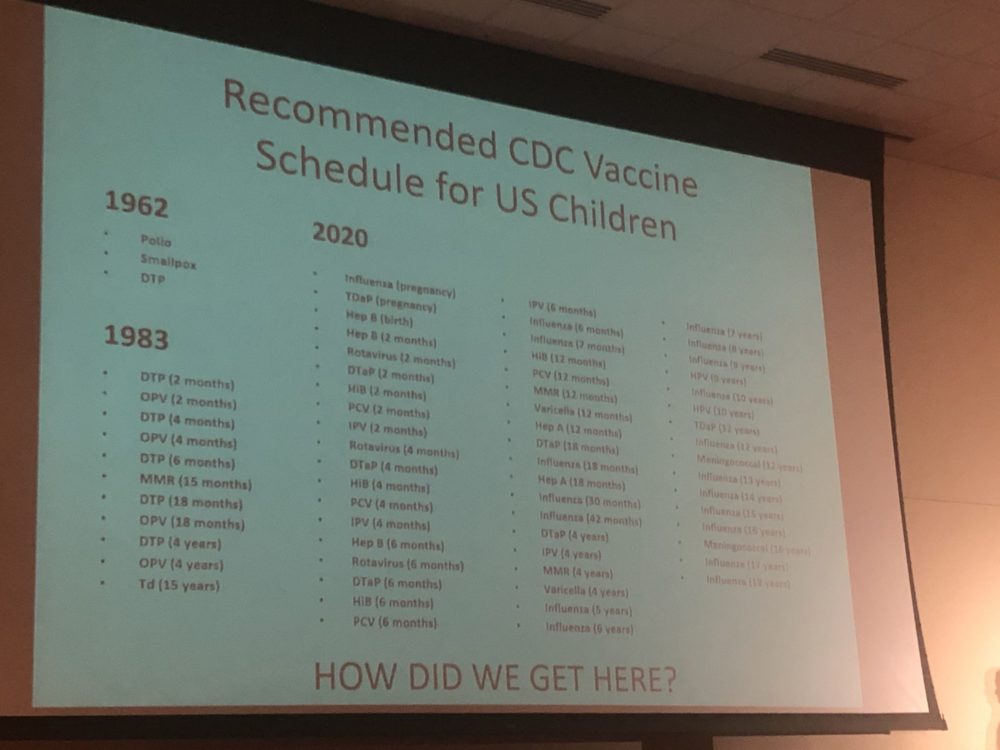Lindsay Maher has a gift for deciphering studies. She’s also not bad with words, as evidenced by her presentation Saturday at Informed Choice Iowa’s conference held at the Des Moines Airport Holiday Inn.
She wasted little time setting the tone, and her presentation will be broken up into shorter stories rather than one long post. By the time she was done talking I had nine pages of notes. After I had written everything I wanted to present from her presentation I was at 13 pages.
So, in an effort not to lose the audience, let’s keep it as short as possible and stay on point. In this first edition, we’ll examine America’s health crisis.
“The secret of freedom lies in educating people whereas the secret of tyranny lies in keeping them ignorant,” Maher said. “Which is what is happening. We’re not being educated.”
According to the CDC, one in six children has a developmental disability — ADD, ADHD, autism, learning and/or mental disabilities, seizures, stammering, stuttering, etc. Fifty-four percent of children have a chronic illness — behavioral problems, asthma, allergies, epilepsy, arthritis, seizure disorder, depression, diabetes.
“I don’t know about you, but when I was growing up I didn’t know very many kids that had many of these,” Maher said.
In the mid-to-late 1980s, chronic health illness in children was around 12.8 percent. The rise to 54 percent is a fourfold increase. During the same time, the vaccine schedule has quadrupled.

Iowa has more than 1.8 million people who have a chronic disease, which is more than half of the state’s population. Maher said that 96 percent of deaths are attributed to chronic disease, accidents and suicide. Chronic disease leads to $19.5 billion in medical costs for Iowa and an extra $7.3 billion is lost in employee productivity every year.
Meanwhile, infectious disease accounts for 2-4 percent of deaths.
“But what do most of our public health programs spend their time doing,” she said.
Public health associations, Maher said, love to talk about how vaccines are saving our productivity.
“But that’s very, very slim,” she said. “You’re only looking at a small piece of the whole pie because chronic disease has an even bigger role in that game.”
America lags behind other wealthy nations in infant mortality. Maher noted that the U.S. has the highest amount of infants dying in their first year of life than any other developed country in the world.
“It’s wrong,” she said. “We have the best healthcare in the world. We have all this money going towards health care, we have all this money going towards research. How is this happening?”
The United States also has the highest mortality ratio among pregnancy-related deaths. It is the only nation with a continued rising rate since the 1980s.
One potential cause, Maher said, is the growth in the U.S. vaccination schedule.
“It’s not talked about much, not researched much,” she said. “We like to blame chronic disease on genetics, lifestyle choices, environmental issues — but never, hardly ever is it talked about the fact that our schedule is now 69 doses before the age of 18 from the womb. See, we go from three vaccines in 1962, one dose a piece, the 1980s, three vaccines several doses. It was like 11 or 12 doses in the 80s. How did we get here? How did we get to this? Is this even necessary?”
Part II will examine just that — how did we get here.












